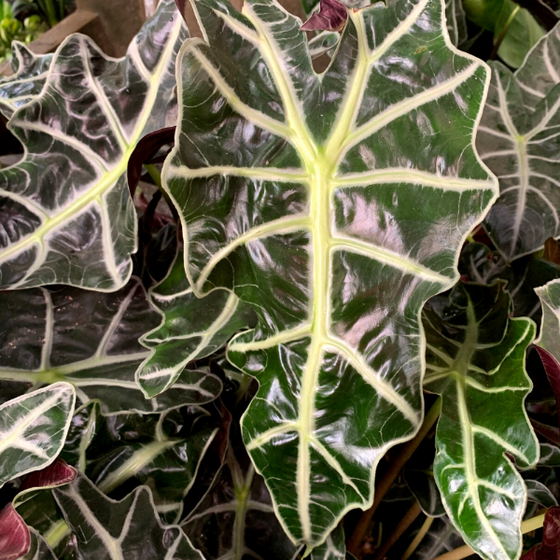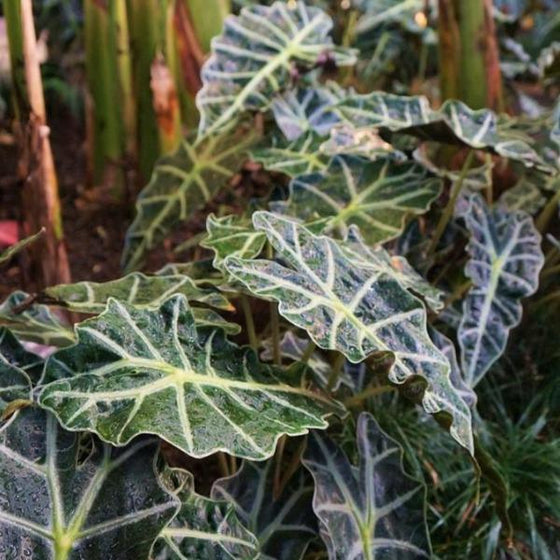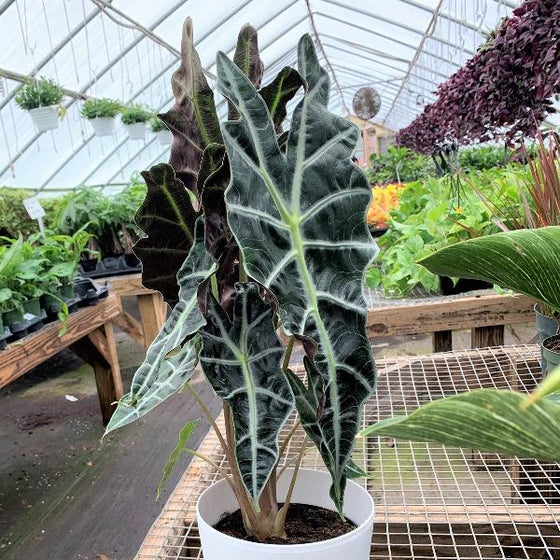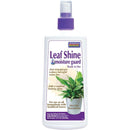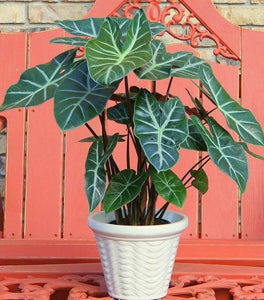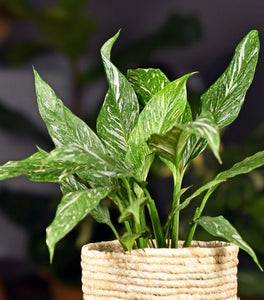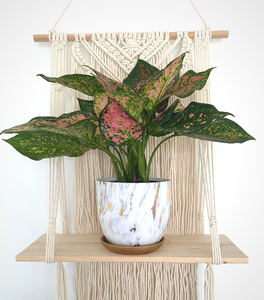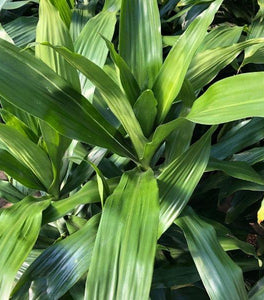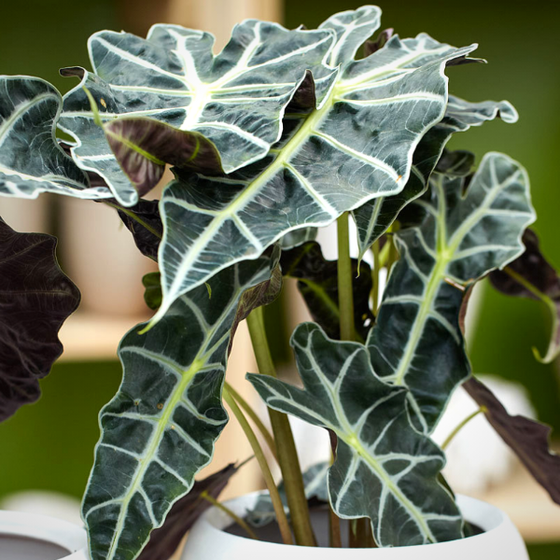
Images Depicted Range in Maturity & Container Size
Pots & Decorations Not Included Unless Otherwise Stated
Alocasia Polly Plants for Sale Online
Alocasia Polly plants, provide a lush, tropical effect in any home. These houseplants can also be outdoor plants near a pond or in a container on a patio or deck as long as the weather supports this plant's growing needs.
Alocasia Polly has rigid, arrow-shaped, deep green leaves complemented with bright white veins held by ebony black petioles. When indoors, these plants love bright, indirect light or filtered sunlight. We recommend placing them near north or east-facing windows.
African Mask plants thrive in warm rooms with some humidity because they are naturally tropical. Unlike other Alocasia plants, these will not grow quite as large, so they can benefit from a plant stand to bring their handsome leaves up to a higher visual point in the room.
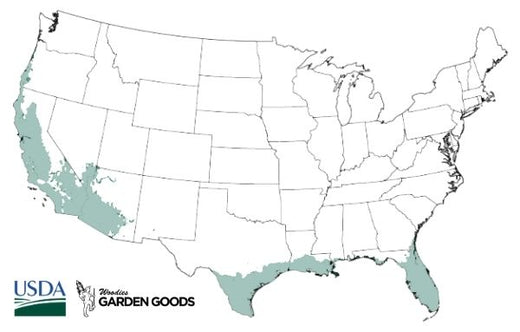
| Hardiness Zone: | 9-11 |
|---|---|
| Mature Height: | 20 to 30 Inches |
| Mature Width: | 20 to 26 Inches |
| Classification: | Tropical evergreen perennial |
| Sunlight: | Filtered to bright indirect light |
| Habit: | Upright |
| Foliage: | Glossy green with white veining |
| Soil Condition: | Average, well draining |
| Water Requirements: | Likes to stay slightly moist, let top inch dry between waterings |
| Uses: | Efficient at cleaning air indoors, does well in most spaces |
How to Care for Alocasia Polly
Before purchasing your new Alocasia Polly Plant, be sure and read all the recommended care instructions to ensure a successful transition to its new home.

What Is The Best Light For Alocasia Polly?
Alocasia Polly Plants are tropicals and are native to areas with filtered light under canopies, but they are not as happy in low light as other tropicals. These plants will be happiest in an area with balanced, filtered light. Bright indirect sunlight will work as well. Do not allow the leaves to be exposed to too much direct sun, because the leaves can scorch easily, leaving big brown spots or even holes in the leaves. Northern or eastern windows work well. If you are going to place your Alocasia Polly in an area with very low or fluorescent light, a grow light for a few hours a day will help it thrive.
How Do I Water Amazonian Elephant Ear Plants?
Alocasia Polly is not a drought-tolerant plant. They need to stay evenly moist in well-draining soil, and they have more trouble bouncing back from underwatering or overwatering than other tropicals. But they certainly can bounce back! A great way to ensure that you are watering your alocasia the right amount is to wait for the top inch or half-inch of the soil to become dry to the touch. Do not wait for the soil to completely dry out, you need to keep the soil moist. Too much water is also bad and could cause root rot if the soil is soggy. If the leaves of your Alocasia Polly have turned yellow, it is probably one of these two watering issues. A humidity tray can help create the humid environment Alocasia Polly prefers. We recommend filtered water or spring water over too hard tap water.

What Is The Best Soil For African Mask Plant?
Alocasia Polly likes evenly moist and well-draining soil. To improve a basic potting soil mix, you can blend it with peat moss for moisture retention and nutrients and perlite or coarse sand to create more drainage. Even though Alocasia Polly likes even moisture and cannot sit in soggy soil so it is important that your soil drains adequately. Letting the soil dry a little bit before watering should help ensure even moisture. Otherwise, they do not have any pH requirements and a well balanced potting soil should do well. We like Espoma's Organic Potting Soil and recommend it for your Alocasia Polly plant or any other house plants.
How Do I Fertilize Alocasia Amazonica?
Alocasia Polly Plants or African Mask Plants can be fertilized monthly with any well-balanced liquid fertilizer during the spring and summer. You should start to slow down the fertilizing routine somewhat in the fall, and you shouldn't need to fertilize during the winter months when your Alocasia is dormant and not growing. Even indoor plants grow more in the spring and summer than they do in the winter, regardless of being inside. We like Jack's Classic Water Soluble Plant Food since it is high quality and you can dilute it to a half-strength if you prefer. There are also slow-release granular fertilizers that work well - be sure to check the specific product instructions for frequency.
Additional Information
Alocaisa Polly is not a difficult house plant, it just likes everything to be just right. Aim for balance in your Alocasia Polly care routine, especially when it comes to light and moisture. Once you've established a great routine and environment for your Amazon Elephant Ear Plant, you'll be rewarded with clean air and a happy, perky plant.
Alocasia Polly is in the same family as Chinese Evergreens, Anthurium, and other Elephant Ear plants. Of all the plants studied by NASA, Alocasias were some of the few plants that removed all of the tested toxins from the air, including benzene, toluene, xylene, trichloroethylene, ammonia, and formaldehyde. While they are good for the air we breathe, do not let your pets or kids nibble the leaves. They are considered toxic to pets by the ASPCA, and they are also toxic to people.
Some plant parents are happy to go all out and invest in lots of technology to create an ideal environment for tropicals. Alocasia Polly plants will certainly benefit from some grow lights and a humidifier, but you do not need to go that far to raise a happy Amazon Elephant Ear if you don't want to. One way to create more humidity within the leaves of your Alocasia is to create a humidity tray. If your plant is still in its nursery pot and that is inside of a decorative pot cover with no holes, this system will work best (since you do not want the alocasia to sit directly in water for extended periods of time). Place the decorative pot (with the plant and nursery pot inside) on a pebble tray that is at least a few inches wider than the base of the pot. Fill the tray with pebbles or decorative glass stones - feel free to get creative. Then, fill the tray with water. That's it, you've successfully provided your Alocasia with an extra boost of humidity. The water in the tray will evaporate into the leaves over the course of the next week. When you water your alocasia, make sure to keep the humidity tray filled as well. If you have a spray bottle nearby, spritzing moisture onto the leaves will have a similar effect.
We think the Alocasia Polly plant is going to have a big comeback as a popular houseplant. Enjoy this tropical treat of a plant while it cleans the air you breathe and makes your home feel just a little bit more polished.

